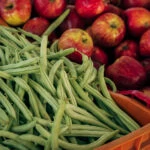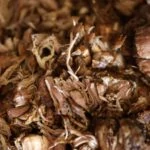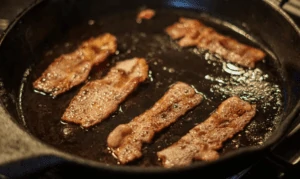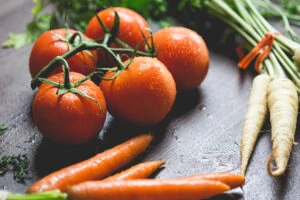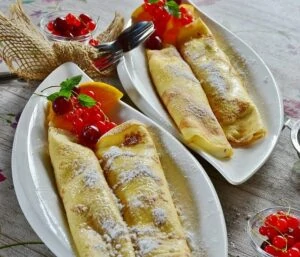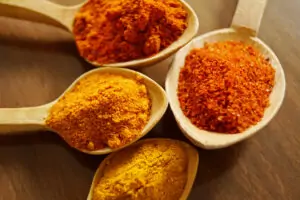Parsley began its debut in the United States with the popularization of French cuisine, which favored curly parsley as a decoration that nobody ate (or so they thought). Luckily, the Italian’s favorite variety, the flat-leafed version, showed that this herb is as delicious as it is beautiful, and the wasteful garnish-only trend is being eaten.
What Is Parsley?
Parsley (Petroselinum crispum) is an herb and cousin of the carrot (they’re both members of the Apiaceae family). Parsley grows around the world, and is native to Southern Europe.
Parsley varieties
There are bunches of parsley varieties, including curly leaf parsley (or French parsley), flat leaf parsley (or Italian parsley), and parsley root.
Curly parsley is usually used as garnish.
Flat leaf parsley is typically used for cooking, is preferred as chopped parsley, and is used to sprinkle throughout or on top of foods.
Parsley root is the root part of a parsley plant, but from a variety different than curly and flat leaf parsley. It’s used as a root vegetable similar to parsnip.
Where to find parsley
Parsley grows quickly and nearly everywhere. It’s hardy, prevailing through both cold and scorching sun.
Purchase parsley
Fresh parsley can be bought in most green grocers. It’s often kept fresh in clam shell containers, and lives with the chilled salads and salad ingredients.
Dried parsley leaves are usually marketed as “parsley flakes,” and you can find them in small glass or plastic spice containers in the spice isle, and in the internet world. Buy a large (around 4 oz) jar of parsley flakes if you make lots of roasts, soups, and vegetable casseroles, or a smaller jar (0.26 oz) if you’re not crazy into Italian or vegetables.
Grow parsley
Parsley is a breeze to grow at home. Like all herbs, plant in nutritious soil for a more nutritional value in your harvest.
Grow parsley in a pot indoors or outdoors, or in the ground.
Harvest the parsley leaves that have a dark green color. Trimming this plant encourages it to produce more. Or, cut the herb back all the way to just a few inches above the soil for a fresh start.
Harvest parsley roots when the weather in your area begins to threaten the first freeze of the season.
Cool weather equals a sweeter harvest, so take advantage of end-of-season picking, or harvest in the morning while the dew is still fresh.
Parsley in the kitchen
Parsley calls on pasta and decorative dishes. It’s often used as a garnish, or to flavor Italian foods, but there are many more uses for this fresh-flavored, nutrient-rich herb.
What does parsley taste like?
Parsley has a slight peppery flavor, and a bitter note that works to brighten other flavors that it’s paired with.
Curly parsley has a milder and sweeter taste that grows in potency as the plant ages, and young, flat-leaf parsley has the strongest “parsley flavor,” since it contains more 1,3,8-menthatriene, an essential oil known as a terpene (nerd out here).
If you’re looking for mild and sweet, pick mature leaves, and bold and slightly bitter and earthy, pick young leaves.
Parsley pairings
Parsley can be overwhelmingly grassy and woody by itself, but it adds bright, fresh, sweet notes to garlic, fats, and acids.
Cooking process
Curly parsley is easy to chop, and its mild, sweet flavors are great in uncooked or otherwise cold dishes. Chop a bunch, including stems, and sprinkle into cold potato or tabbouleh salad. Then go rogue and use a sprig on top for decoration.
Flat leaf parsley (Italian parsley) can go either way –fresh or cooked. Fresh, its potency highlights sours like lemon, and combines fats like chickpeas and other legumes, tahini, and cheeses. Cooked, flat leaf parsley gives a light earthy-sweet flavor to baked goods, stews, pasta, white sauces, fish (try tilapia), and white meats.
Parsley’s stems hold the bulk of the herb’s flavor, and should be included fresh or cooked if you can chop them small or break them down in a processor to avoid their annoying texture.
If you are baking a dish that calls for parsley to be added to the top, wait until you are about to serve the cooked meal before adding the parsley. If you bake a dish with parsley mixed in, it will be okay. However, be aware that parsley can wilt and scorch very easily when under a broiler, for example if adding to garlic bread.
How to store parsley
Both fresh parsley and dried parsley store best in an airtight container in a dark, cool place.
Use dried parsley within six months to take advantage of its fullest flavor.
Health benefits of Parsley
Parsley has lots of vitamins vital to our health, and studies suggest it is a rich source of vitamin A, vitamin C, and vitamin K.
Used as a fresh herb in large quantities, like in pesto, parsley juice, or in fresh salads, research suggests that parsley can support proper blood clotting, improve bone health, lower blood sugar levels, regulate high blood pressure, reduce oxidative stress, improve digestion, and protect against heart disease. Parsley also has antioxidant properties that help the body to fight against other health problems.

